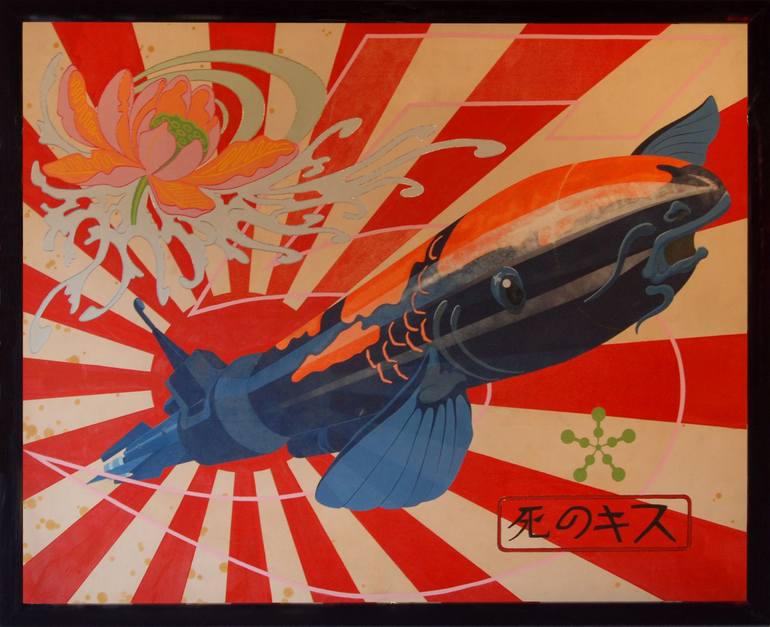







VIEW IN MY ROOM
Kaiten Painting
United Kingdom
Painting, Acrylic on Canvas
Size: 103.1 W x 82.7 H x 3.1 D in
Ships in a Crate
Shipping included
14-day satisfaction guarantee
Artist Recognition

Artist featured in a collection
About The Artwork
Return to the sky. The metaphysical transformation of the Koi breeder. The image of the Kaiten represents the ultimate sacrifice a man can make for his country. To give his life with honour in service to his country. Piloted by a Koi breeder this Kaiten is transforming into Koi, the fish that he loved the most and which will give him the strength to fulfil his mission. In Japan, the koi is associated with perseverance in adversity and strength of purpose. Because of its strength and determination to overcome obstacles, it stands for courage and the ability to attain high goals. Longevity, love and transformation are also associated with the Koi and these represent the future for Japan. The lotus flower floating away from the Kaiten represents the moving away from violence to a more peaceful philosophy of existence. The large No 5 symbolises the conceptual framework known as the Godai, or, the Five Elements of Void/Sky/Ether/Power, Wind/Air, Fire, Water and Earth from which everything in the universe is perceived to be a manifestation of these five great elemental 'building blocks'. The Artists interpretation of the piece is the metaphysical transformation of war and peace. As the Kaiten heads towards its inevitable end it transforms in to peace and love, the overpowering conspectus of the pilot. Living a peaceful, harmonious life, he only wishes to return to that way of life. Rising above the transformation is the pink lotus, spreading it roots across the Kaiten, symbolising the hope that out of all the death and pain peace will come and from that a clearer understanding of man’s interaction with man. That war only leads to loss and anger and regret. The 3 rings are interpreted as a broadcast to the world to live in harmony.
Details & Dimensions
Painting:Acrylic on Canvas
Original:One-of-a-kind Artwork
Size:103.1 W x 82.7 H x 3.1 D in
Frame:Black
Ready to Hang:Not applicable
Packaging:Ships in a Crate
Shipping & Returns
Delivery Time:Typically 5-7 business days for domestic shipments, 10-14 business days for international shipments.
Handling:Ships in a wooden crate for additional protection of heavy or oversized artworks. Crated works are subject to an $80 care and handling fee. Artists are responsible for packaging and adhering to Saatchi Art’s packaging guidelines.
Ships From:United Kingdom.
Customs:Shipments from United Kingdom may experience delays due to country's regulations for exporting valuable artworks.
Have additional questions?
Please visit our help section or contact us.
United Kingdom
The DANGEROUS MINDS ARTISTS Studio was founded by Michael Lake-McMillan and Alan Stuart. The artists’ distinctive work constantly refers and returns to the touchstones of light, beauty in decay, abandonment and antiquated typography. Dangerous Minds practice is driven by duality. The pairs’ intuitive subliminal dialogue centres on point and counterpoint and the production of works that are, fundamentally, aesthetically appealing and which, on further inspection, inspire curiosity and cause a ripple of intellectual stimulation. Subject matter is considered in depth, deconstructed then reformulated with an essential duality at its core, often incorporating ambiguous or cryptic text elements relating to a parallel narrative. Key to their oeuvre is the juxtaposition of the immediately apparent and that which only becomes visible through physical change – either in the position of the viewer or in the lighting of the work, whether specifically engineered or occurring naturally with the transition of day into night.
Artist Recognition

Artist featured by Saatchi Art in a collection
Thousands Of Five-Star Reviews
We deliver world-class customer service to all of our art buyers.
Global Selection
Explore an unparalleled artwork selection by artists from around the world.
Satisfaction Guaranteed
Our 14-day satisfaction guarantee allows you to buy with confidence.
Support An Artist With Every Purchase
We pay our artists more on every sale than other galleries.
Need More Help?